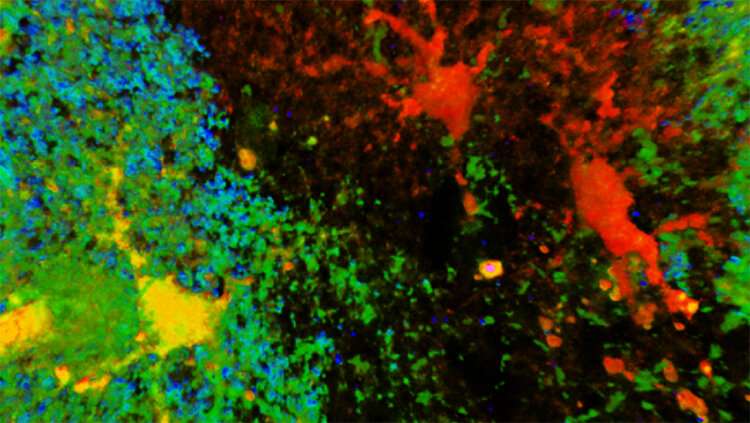3D reconstructed confocal image depicting cortical grey matter of a mouse after repetitive diffuse mild traumatic brain injury (rdTBI). We demonstrate a new subtype of atypical reactive astrocytes characterized by downregulation of homeostatic proteins: glutamate transporter 1 (blue) and S100β (green). Interestingly, atypical astrocytes do not undergo cell death after rdTBI, but rather have an enhanced expression of fluorescent protein tdTomato (red). In our model, mice develop spontaneous seizures and we link post-traumatic epileptogenesis with atypical astrocytes. Credit: Oleksii Shandra
Researchers have identified a cellular response to repeated concussions that may contribute to seizures in mice like those observed following traumatic brain injury in humans. The study, published in JNeurosci, establishes a new animal model that could help improve our understanding of post-traumatic epilepsy.
Stefanie Robel, Oleksii Shandra and colleagues induced mild traumatic brain injury in mice to mimic blows to the head that result in human concussions. A unique population of astrocytes responded to these injuries and the researchers observed spontaneous recurrent seizures in some mice within one month.
These results highlight the role of astrocytes in the development of epilepsy following the most common type of traumatic brain injury in humans.
Video of the two-photon z-projection demonstrating the loss of GFP (green) by cortical astrocytes 24 hours following diffuse traumatic brain injury in a live mouse. Credit: Oleksii Shandra
Video with a 3D reconstructed confocal image of reactive astrogliosis in the cortex of a mouse following diffuse traumatic brain injury. GFP - green; GFAP - red; Dapi - blue. Credit: Alexys Harrington
More information: Repetitive Diffuse Mild Traumatic Brain Injury Causes an Atypical Astrocyte Response and Spontaneous Recurrent Seizures, JNeurosci (2019). DOI: 10.1523/JNEUROSCI.1067-18.2018
Journal information: Journal of Neuroscience
Provided by Society for Neuroscience























